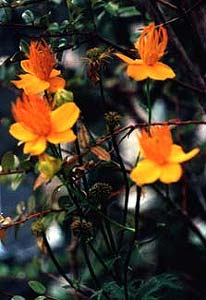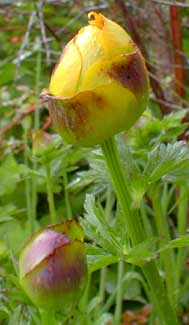
'Golden Queen'
Globeflower
"I dismount
to draw water where
the globeflower's
dewy blossoms drip into
Ide's Tama River."
-Shunzei
1114-1204
1114-1204
I obtained this 'Golden Queen' globeflower in mid to late summer in 2002, when it was in full bud for what was apparently a rebloom.The blooms opened flatter than other globeflowers so that the discriptive name "globe" is not so much applicable.
 The following year the clump had enlarged just a little bit, & it began blooming furiously in late June & like the first year rebloomed right into September. The first two photos show it in August & September. Then by 2004 it was quite a big sturdy clump in full flower before the end of May. The third photo shows a mid-May bud, which are quite attractive even before they begin to open. Deadheading keeps its lengthy bloom time reliable, & the flowers are excellent for bouquets.
The following year the clump had enlarged just a little bit, & it began blooming furiously in late June & like the first year rebloomed right into September. The first two photos show it in August & September. Then by 2004 it was quite a big sturdy clump in full flower before the end of May. The third photo shows a mid-May bud, which are quite attractive even before they begin to open. Deadheading keeps its lengthy bloom time reliable, & the flowers are excellent for bouquets.The clump is growing on the periphery of a stand of Evergreen Huckleberries, the leaves of which are framing the blooms in both photos, the first snapped in August, the second in September. Its foliage is three feet below the bloom stems, being deeply serated & almost ferny.
 This hybrid was created from the relatively late-blooming & tender Chinese Globeflower (T. chinensis) crossed with the taller & hardier Ledebour Globeflower (T. lebourii), getting the best traits from both species. This & other globeflower crosses are sometimes sold under the hybrid name T. cultorum.
This hybrid was created from the relatively late-blooming & tender Chinese Globeflower (T. chinensis) crossed with the taller & hardier Ledebour Globeflower (T. lebourii), getting the best traits from both species. This & other globeflower crosses are sometimes sold under the hybrid name T. cultorum.'Golden Queen' is truly the queen of the buttercup family, having strongly erect stems requiring no staking, rising up to four feet from out of three-lobed serated basal foliage, each stem topped by the largest brightest tangerine blossoms which are magnets for butterflies & bees. It justly received the Award of Garden Merit from the Royal Horiticultural Society.
As with all globeflowers, it requires very moist conditions & is appropriate to the bog garden, thrives in poorly draining clayey soils, but will easily adapt to well-drained soil too. Bred from wildflowers that preferred marshy meadows, it will not tolerate outright dryness.
On Puget Sound it prefers a great deal of sun to bloom at its maximum, though it will survive in partial shade & is suitably used as a shade-plant to bring color to the sunnier periphery of a shade garden. The further south it is grown, however, the more protectiton from sunlight it will require. It dies back at the end of autumn & remnants of foliage may need cutting back after final bloom or it will soon be very tatty.